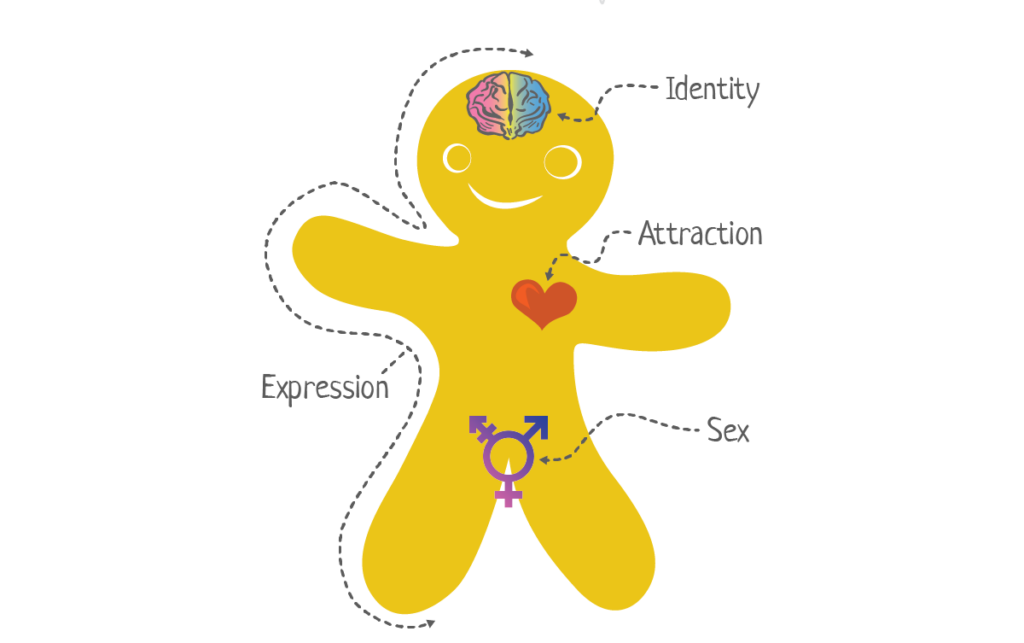Difference between gender and sexual orientation

Gender identity and sexual orientation are different personality characteristics. Gender identity is personal (how you see yourself), it is about how you define yourself in relation to your own gender. While sexual orientation is interpersonal (who you physically, emotionally and/or romantically attracted to).
Traditional societal norms often dictate strict rules for how people “should” act, dress, and express themselves based on their assigned sex at birth, while promoting heterosexuality as the only acceptable sexual orientation. Gender non-conformity, regardless of sexual orientation, can lead to prejudice and discrimination, harassment. Individuals who do not fit these conventional molds can experience immense internal conflict, shame, and pressure to conform, potentially leading to mental health struggles and a sense of inauthenticity. Also, individuals can face rejection and institutional barriers. Families, friends, or entire communities may reject individuals based on their gender identity or sexual orientation, leading to loss of support systems. Discrimination in essential areas like healthcare, education, and employment can severely impact quality of life and opportunities.
It is often mistakenly assumed that gays and lesbians are gender non-conforming and/or transgender. Similarly, a person who exhibits gender-atypical behaviour may be considered lesbian or gay, regardless of that person’s actual sexual orientation, so it is important to understand the differences between gender identity and sexual orientation.
Gender identity is an individual’s deeply held sense of being male, female or another gender. While sex is often referred to as something more biological, gender is a social construct. Some children become aware at a very young age that their gender identity does not align with their physical sex characteristics. Other transgender and gender-expansive people recognize their gender identity during adolescence or adulthood.
It’s also important to note that some people don’t think any of these labels describe them accurately. Some people don’t like the idea of labels at all. Other people feel comfortable with certain labels and not others.
Sexual orientation is how you define yourself through the people you fall in love with and/or are attracted to. Some people fall in love with a person of the same gender, some with a person of the opposite gender, some with all genders and to some, gender does not matter when it comes to who they love. Sexuality can be fluid just like gender; however, it is mainly in relation to the other person. While sexuality usually refers to romantic and sexual attraction, not everyone feels both forms of attraction. Some are only romantically interested in someone, others only physically, and some do not experience either.
In multiple studies, LGBT youth reported being aware of their sexual orientation during elementary school, but waited to disclose their orientation to others until middle or high school.
It is also important to realise that gender non-conformity can further increase the stigmatisation of homosexual and bisexual people. To effectively address gender non-conformity, it is necessary to be aware of one’s own values and beliefs in relation to one’s biological and social sex and sexual orientation.
For families can help:
- Learn together. Find easy-to-understand books or websites about being LGBTQ+. Learning shows that you care.
- Listen with love. Let your child talk about how they feel without judgment.
- Find support. If it feels right, find groups where they can meet other LGBTQ+ people and their families.
For schools can help:
- Teach about everyone. Include lessons about different kinds of families and important people from LGBTQ+ history.
- Zero-Tolerance policies! Have clear rules against mean words or actions about someone being different.
- Show that they care. Posters or books showing support for all students matter.
For workplaces can help:
- Fair rules. Make sure no one can be treated badly for being LGBTQ+.
- Learn to be respectful. Teach everyone the right words to use and how to support coworkers.
- Show you are an ally. It is okay for coworkers to show that they support a safe workplace for everyone.
We are all different. People can be all sort of ways – that is what makes the world interesting. If you are not sure about something, asking politely shows you want to understand. It is important to understand that everyone deserves to be themselves, just like you want to be you, other people want the same respect.
The video provides an exemplary tutorial on comprehending gender concepts, emphasising the differentiations between gender identity and sexual orientation and between gender and sex. The presenter underscores the significance of acknowledging gender as a continuum, employing the “genderbread person” paradigm to clarify these notions. The session aims to inform attendees about the socially constructed nature of gender roles, which are shaped by cultural conventions and societal demands.
The workshop examines the notion of intersectionality, emphasising how gender-based prejudice intersects with additional disparities of a social and economic nature. Through interactive exercises and collective deliberations, attendees are motivated to examine and contemplate their understanding of gender and the influence that societal conventions have on personal identity and conduct.
It is imperative to have a nuanced comprehension of gender issues, as the video emphasises that gender roles and expectations are ever-changing and culturally and historically contingent. It concludes with a demand for ongoing education and dialogue to challenge and alter gender-related stereotypical beliefs and practices. The goal of this pedagogical approach is to cultivate a more equitable and inclusive society wherein people are able to openly and without discrimination declare their gender identity.